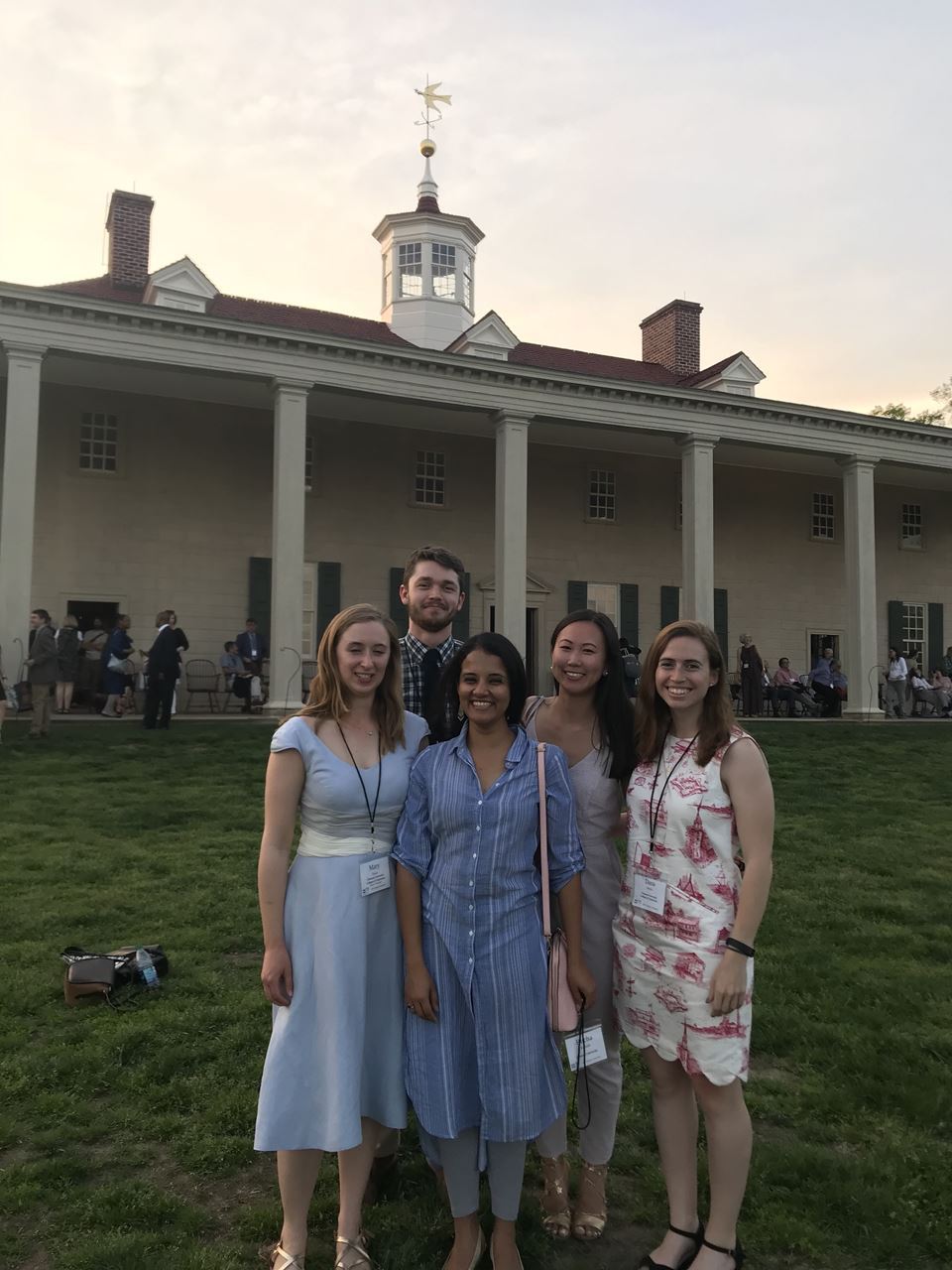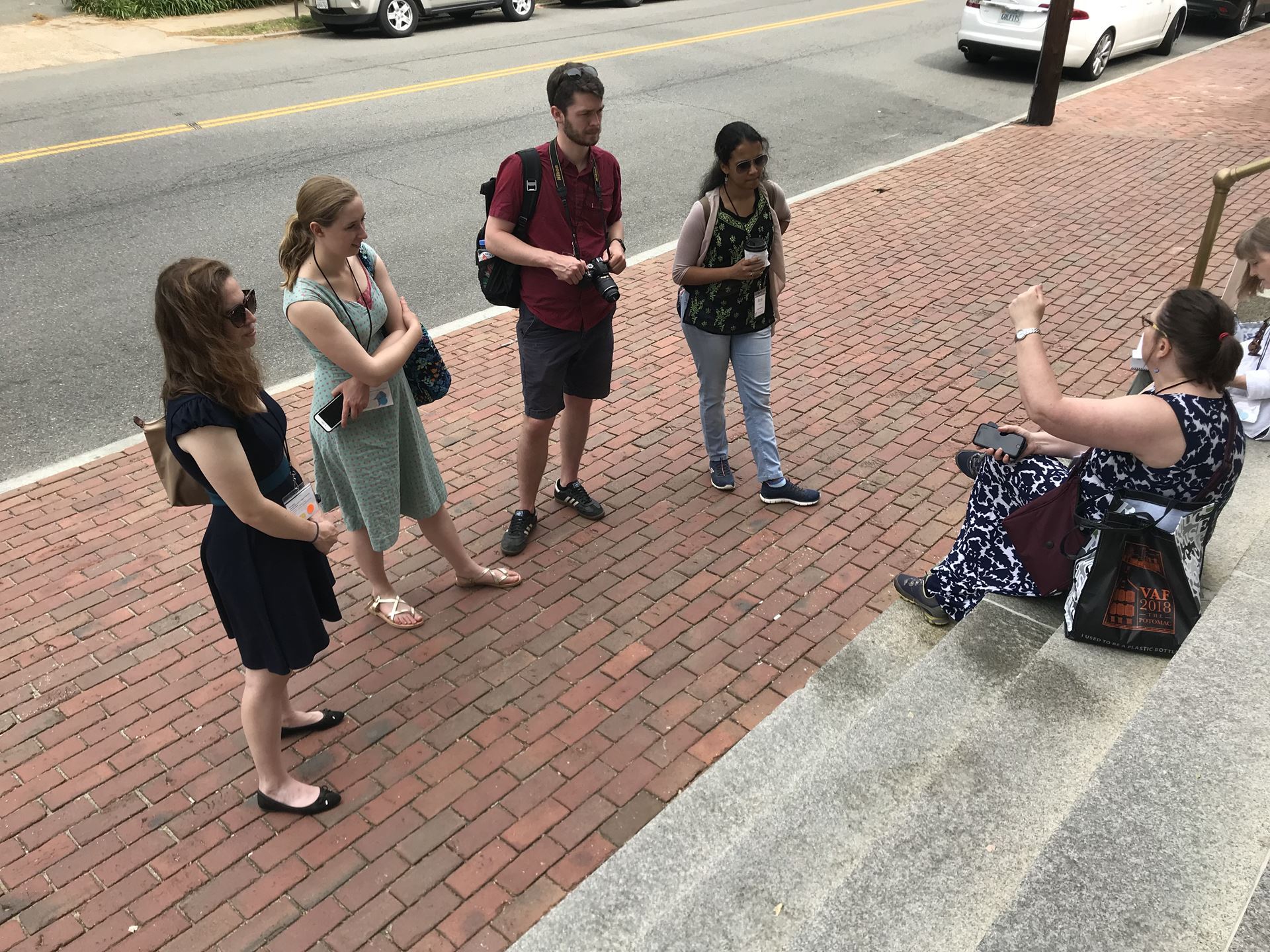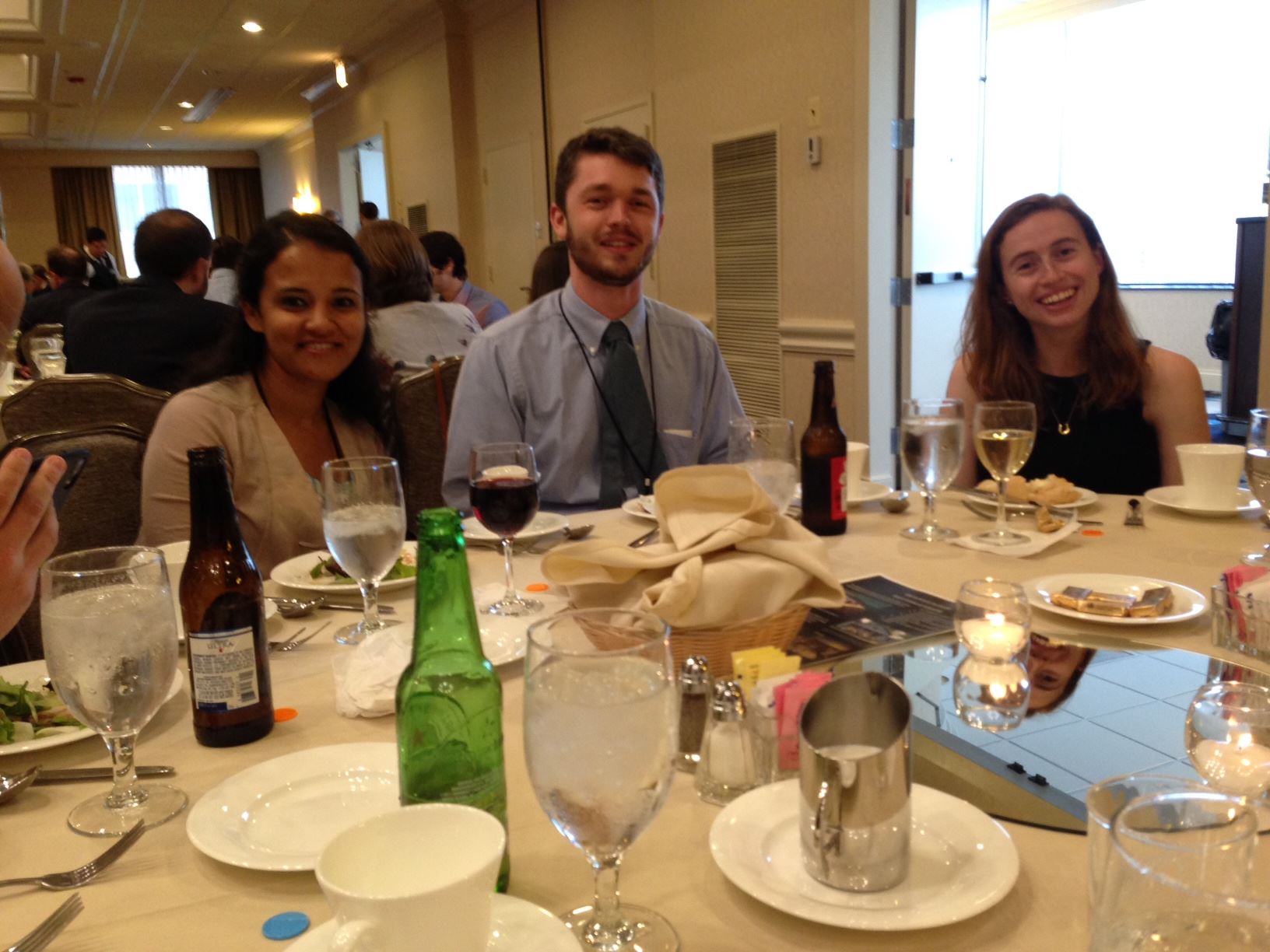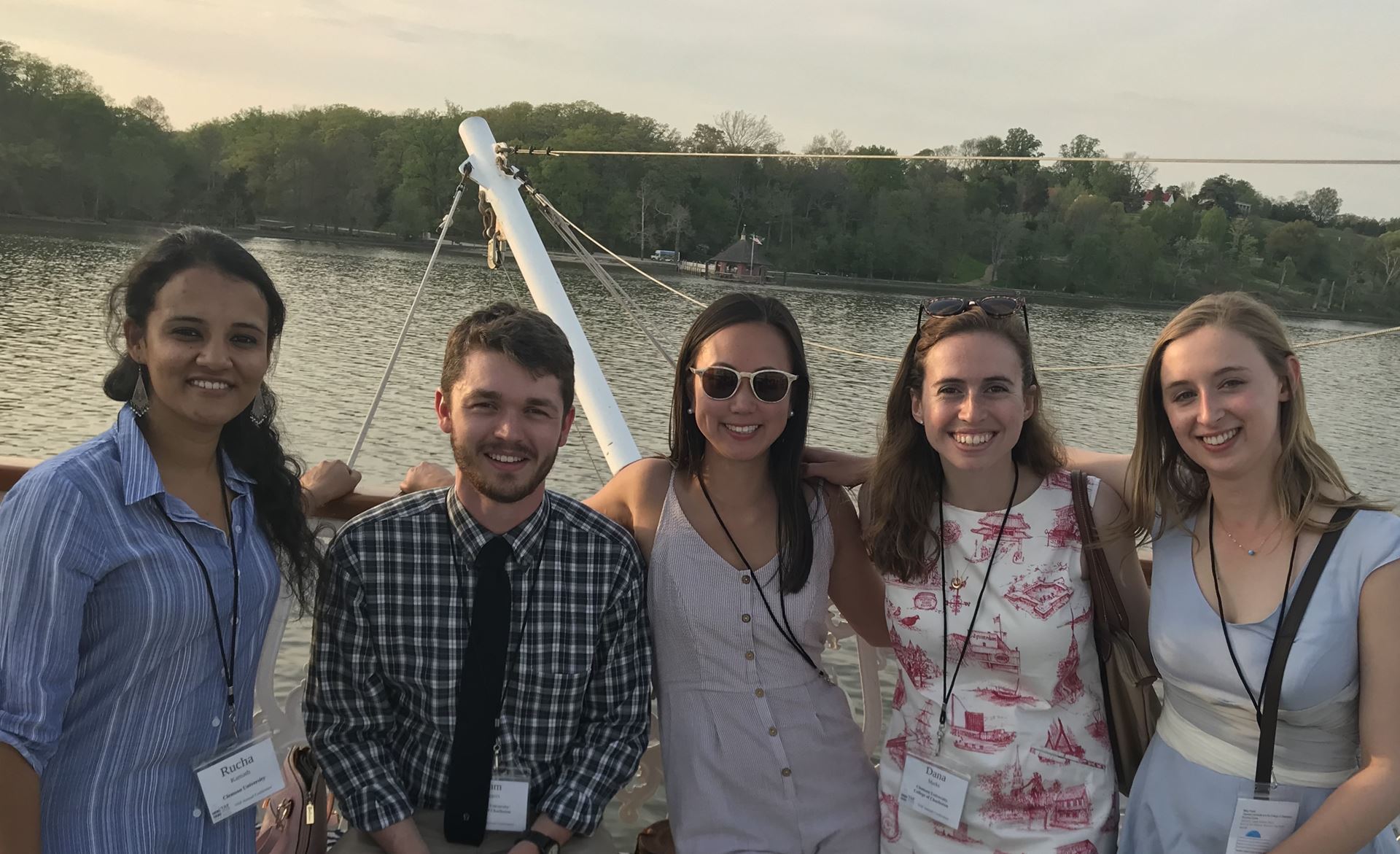
Our small contingent got engaged with VAF 2018 early, in October prior to the meeting, when we spent our Fall Break documenting buildings at Hard Bargain Farm in Prince George County, MD that would be part of the Thursday field trip. Second Year students Matt Amis, Sam Biggers, and Lauren Lindsey and First Year students Rucha Kamath and Dana Marks accompanied Professor Carter Hudgins and Amalia Leifeste to Hard Bargain where we bunked in cabins used throughout the year by campers who participate in environmental education programs sponsored by the Alice Ferguson Foundation. Over the course of three days, we completed site plans for the Ferguson’s house, its gardens and support buildings, the farm, and a mid-nineteenth century tobacco barn and stripping shed, corn houses, and modern equipment sheds that had sprung up around it. At the end of our stay we had also completed field drawings for plans of the first floor of the Fergusons’ house and its outbuildings and the ground plan of the farm’s mid-twentieth century dairy barn. All of these were translated into AutoCAD and sent to our pals with the Maryland Historical Trust for inclusion in the 2018 field guide.
 When we returned to Maryland, our Ambassador contingent consisted of First Year students Rucha Kamath, Kyunhea Kwon, and Dana Marks and Second Year Students Sam Biggers and Mary Fesak, the recipient of one of this year’s Pam Simpson Presenter’s Award. Following the cruise to Mount Vernon and the opening session, we organized in two groups for Thursday’s tours, one led by Professor Leifeste for the Tour I: Upper Western Shore, the other loosely organized by Professor Hudgins for Tour II: Lower Western Shore. While the Tour I group (Biggers and Fesak) was keen on seeing parts of Maryland they had not seen in the Fall, our Tour II group (Kamath, Kwon, and Marks) welcomed the opportunity it gave them to see Hard Bargain Farm again. Friday found us spread across Alexandria, our team coalescing and dissolving through the day as we made lists and checked them twice of the buildings Carl Lounsbury and other old VAF hands told us, “don’t miss this one.” At the end of the day, we met at Virtue Feed & Grain for a social hour with graduates of our program now working in the Washington area.
When we returned to Maryland, our Ambassador contingent consisted of First Year students Rucha Kamath, Kyunhea Kwon, and Dana Marks and Second Year Students Sam Biggers and Mary Fesak, the recipient of one of this year’s Pam Simpson Presenter’s Award. Following the cruise to Mount Vernon and the opening session, we organized in two groups for Thursday’s tours, one led by Professor Leifeste for the Tour I: Upper Western Shore, the other loosely organized by Professor Hudgins for Tour II: Lower Western Shore. While the Tour I group (Biggers and Fesak) was keen on seeing parts of Maryland they had not seen in the Fall, our Tour II group (Kamath, Kwon, and Marks) welcomed the opportunity it gave them to see Hard Bargain Farm again. Friday found us spread across Alexandria, our team coalescing and dissolving through the day as we made lists and checked them twice of the buildings Carl Lounsbury and other old VAF hands told us, “don’t miss this one.” At the end of the day, we met at Virtue Feed & Grain for a social hour with graduates of our program now working in the Washington area.
 This was Sam Bigger’s second VAF conference (his first was the 2016 North Carolina meeting). For the rest of his classmates, this first VAF experience was for them, they told us during the eight-hour drive back to South Carolina and by email, a great networking opportunity. Told as they boarded for Mount Vernon on Wednesday evening that they were about to drop into what for many VAFers is an annual family reunion, our students, after the initial reluctance all newcomers feel, met familiar names and struck up conversations with other students that would continue through the conference. “This really is a friendly group,” said one. That conclusion, our students agreed, was easy to draw while sitting on the piazza at Mount Vernon, or figuring out who got to go first into the next basement or attic, or sharing what you knew about wall paper, or framing, or regional foods, or some other topic with someone who five minutes before was a total stranger. Looking back at the conference, Rucha Kamath recalled her impression that VAF is “a culture in itself where architecture serves a medium and a platform for people to connect and enhance their understanding of the historic past.” Dana Marks, a Montgomery County native, told us that she was grateful that the meeting offered an un matched opportunity to” get to know so many other preservation professionals while visiting a large variety of sites.” There was between site visits, walking tours and paper sessions, Dana recalled, “much new information to absorb” that “gave me lots of ideas for potential research moving forward.”
This was Sam Bigger’s second VAF conference (his first was the 2016 North Carolina meeting). For the rest of his classmates, this first VAF experience was for them, they told us during the eight-hour drive back to South Carolina and by email, a great networking opportunity. Told as they boarded for Mount Vernon on Wednesday evening that they were about to drop into what for many VAFers is an annual family reunion, our students, after the initial reluctance all newcomers feel, met familiar names and struck up conversations with other students that would continue through the conference. “This really is a friendly group,” said one. That conclusion, our students agreed, was easy to draw while sitting on the piazza at Mount Vernon, or figuring out who got to go first into the next basement or attic, or sharing what you knew about wall paper, or framing, or regional foods, or some other topic with someone who five minutes before was a total stranger. Looking back at the conference, Rucha Kamath recalled her impression that VAF is “a culture in itself where architecture serves a medium and a platform for people to connect and enhance their understanding of the historic past.” Dana Marks, a Montgomery County native, told us that she was grateful that the meeting offered an un matched opportunity to” get to know so many other preservation professionals while visiting a large variety of sites.” There was between site visits, walking tours and paper sessions, Dana recalled, “much new information to absorb” that “gave me lots of ideas for potential research moving forward.”
 Most of our students told us that they knew a good bit about Washington’s public places and spaces but nothing at all about rural Maryland or Alexandria. In that sense, this group was not unique. Kyunhea Kwon summed up her first VAF meeting this way: “I loved this experience beginning with our private tour of Mount Vernon with cocktails on George Washington's porch to the amount of time we spent in the field, climbing ladders and exploring basements and attics of tremendous buildings.” Kyunhea was not alone when she said that VAF 2018 reinforced for her the centrality of figuring out “how the buildings have changed over time” to mapping out historic preservation strategies.
Most of our students told us that they knew a good bit about Washington’s public places and spaces but nothing at all about rural Maryland or Alexandria. In that sense, this group was not unique. Kyunhea Kwon summed up her first VAF meeting this way: “I loved this experience beginning with our private tour of Mount Vernon with cocktails on George Washington's porch to the amount of time we spent in the field, climbing ladders and exploring basements and attics of tremendous buildings.” Kyunhea was not alone when she said that VAF 2018 reinforced for her the centrality of figuring out “how the buildings have changed over time” to mapping out historic preservation strategies.